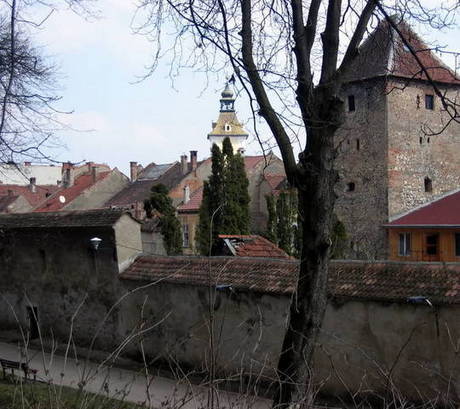Brasov's Defensive Fortifications
Ever since Saxon settlers arrived in the early 12th century, invading Mongols, Turks and others gave them a tough time, repeatedly destroying the old settlements of Bartholoma and Corona. Thereafter, the Saxons set themselves to building fortifications around their town.
Most work was done between 1400 and 1650, when outer and inner walls were erected, together with massive defense towers and gates. Part of the defensive wall, once 40 feet high, seven feet thick and two miles long, can still be seen today, though most was taken down in the 19th century to make room for the city's expansion.
Of the original seven bastions, only a few have survived, including the newly renovated Graft Bastion, located in the middle of the citadel's northwest wing. On the west side of the wall, walk along picturesque Dupa Ziduri Street (Dupa Ziduri means Behind the Walls) to catch a glimpse of the 15th century White and Black Towers. The Blacksmiths' Bastion, one of the original seven built and guarded by the city's guilds, is located at the southern end of Dupa Ziduri Street. Follow the city wall southeast to the fairy-tale Catherine's Gate. Built in 1559 and once the main entrance to medieval Kronstadt, it is the only original city gate to have survived the test of time. Nearby is the classicist Schei Gate, built in 1827. The Weavers' Bastion can be admired on George Cosbuc Street.
Graft Bastion (Bastionul Graft)
The newly restored 16th century bastion (1521) has four levels, accessible through interior staircases. Levels two, three and four host an array of medieval artifacts exhibits, while level one serves as a rest area for visitors.
White Tower (Turnul Alb)
Located near Graft Bastion, the semicircular White Tower was completed in 1494. A wooden staircase spirals up four levels, offering a great view of the old town. Located high on a hill, you'll have to climb some 200 steps to reach it.
Black Tower (Turnul Negru)
The squared Black Tower, also built in 1494, stands atop a rock on Starja Hill near the Blacksmiths' Bastion. The tower received its name from a severe fire in 1559 when it was struck by lightning. Recently renovated and boasting a pyramid-shaped glass roof, the Black Tower houses a small war-related artifacts museum. There are four floors inside, each reached by a narrow wooden ladder. Climb all the way to the top for a panoramic view of the Black Church.
Blacksmiths' Bastion (Bastionul Fierarilor)
First attested in 1529, the Blacksmiths' Bastion is now home to the Brasov Archives which hosts more than 100,000 old and rare documents, including 80 valuable 14th - 16th century letters. Among them is the oldest letter in the Romanian language, written in 1521 by Neacsu, a merchant from the town of Campulung.
Catherine's Gate (Poarta Ecaterinei)
Catherine's Gate, erected in 1559 by the Tailors' Guild, is the only original gate to have survived from medieval times. The fairy-tale tower we see today was part of a bigger structure, which unfortunately, was demolished in 1827. The original structure can be seen at the Weavers' Bastion Museum where a large model of 16th century Brasov is displayed. The four small corner turrets (as seen in other Saxon citadels) symbolized the judicial autonomy of the Town Council which could apply, if necessary, the death penalty. Above the entrance, the tower bears the city's coat of arms: a crown on a tree trunk.
Schei Gate (Poarta Schei)
Entry to the Schei district from the walled city was marked by the Schei Gate. Old documents mention it, also, under the name of Porta Valacce (Wallachs'Gate) because it was the only entrance for the Romanians living in Schei. They were not allowed to use any of the other entrances. The structure standing today was built in 1827 by Emperor Franz I and replaced the old Schei Gate which had been heavily damaged by fires. The gate resembles a triumphal arch with three openings. Above the small arches on both sides, you can see Latin inscriptions.
Weavers' Bastion (Bastionul Tesatorilor)
Built during 1421-1436 and rebuilt in 1570-1573, this is the largest medieval bastion in Brasov and the best-preserved among the seven original watchtowers constructed around the city walls. Today, the Weavers' Bastion houses an interesting museum that can be visited on the way up Tampa Mountain. This small museum, housed inside the bastion, exhibits Middle Age documents, photographs of long-lost bastions, armor, impressive Turkish weapons decorated with Arabic inscriptions, tools used by local artisans, guild flags, a street lamp from the 16th century, pieces from an aqueduct, rare books and much more. Most impressive is the elaborate small-scale model of Brasov circa 1600, made in 1896 for the Millennium Exhibition in Budapest.




